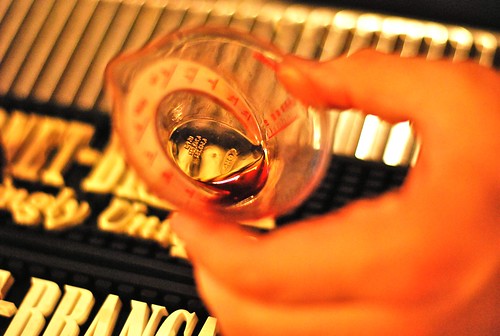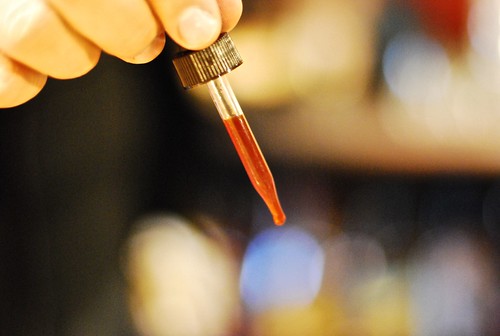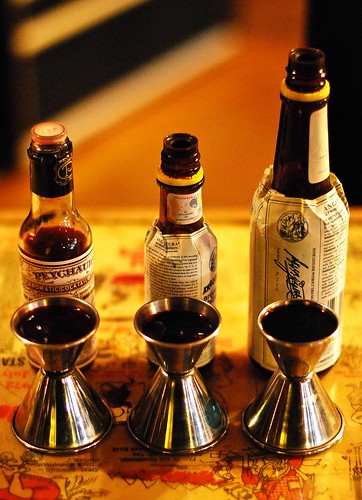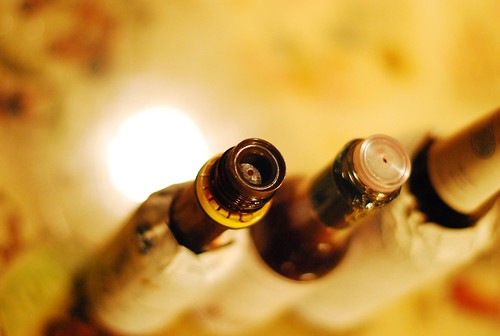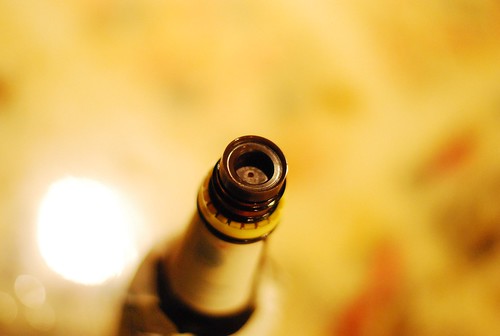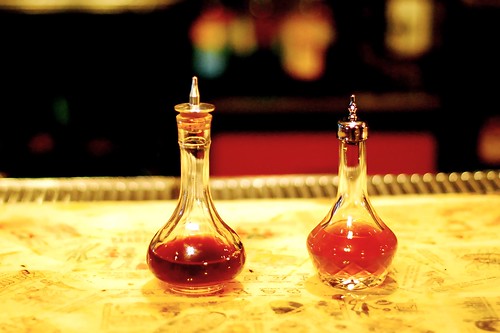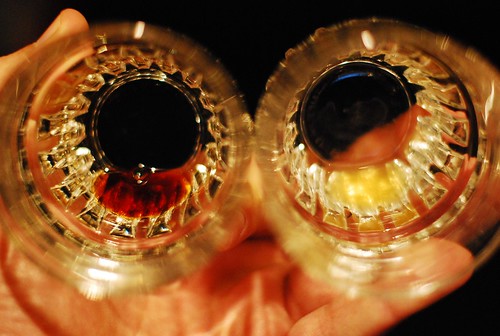
READER BEWARE!!! This post is on intergalactic levels of NERDness! It's intended to help those worried about making consistently good drinks. If you're one such person, read on. Otherwise, if you'd like to take things easy, and enjoy something a bit less nerdy, FEAST YOUR EYES on THISSS!
Wow... back on topic... Where was I? Nerds... bitters... Yep!

At Eldo, we're becoming more and more aware of the pre-prohibition bartender's long-lost techniques, as well as the modern folks who pledge to continue the efforts of their predecessors. The goal? Bring the profession back to common knowledge as a true craft.
At Eldo, we took a major step when we created Housemade Bitters. Although, this only sparked another big concern: Accurate Measurement.
Making a quality cocktail is no challenge. All ya do is follow a recipe, right!?! Try making that cocktail consistently good... Say a hundred or so back-2-back-2-back-2... Then, try to teach a group of people how to make that cocktail, and tell me if they're able to create the drink exactly as you, or each other do... A slight adjustment to the amount of booze, syrup, or citrus will dramatically change the quality of a drink. This is why we jigger when constructing drinks. This principle is easily understood when dealing with the cocktail world's most EXTREME – yes, I used extreme – ingredient: BITTERS (it's like Mountain Dew to the Sky-Diving industry... sorta)
That being said, many of the greatest cocktail recipes require bitters for good reason. There's no doubt they have a profound influence on the flavor of a cocktail. Only one drop (not a dash!) will enhance – or ruin – the flavor of a drink. So, it's no wonder that the folks who make bitters use dasher lids to control the amount dispensed from their bottles.
When it came time to bottle our bitters, we used eye droppers. But how does a dropper equate to a dasher? Mmmmm...
Experiment 1: How many drops are in a Dash?
We started by saving the SECOND of two consecutive dashes in a measuring cup. Why the second? Because, the first dash was consistently smaller – roughly half the size.
Then, we used a small eye dropper (one that fits a 2 oz droppper vile) to soak up the dash. One dash was the maximum capacity of a full draw (roughly 25 drops). We tested several different dashes to be sure. Each was the same result! This was great for us because it guaranteed that the full draw of an eye dropper was "A Dash" -- Or was it...
Somewhere along the experiment, I discussed the topic with a friend in the industry, and he had to go and drop a bomb on our little party. NOT LIKE THAT... you have filthy minds! No, no, no... He pointed out that different brands of bitters use different size lids! To which I reply, "WHAT THE DEUCE!"
Experiment 2: How many dashes are in a fluid oz.?
We started by using a 10 oz bottle of Angostura. We averaged 32 dashes per oz. Then, we tested a different brand of bitters. 32 dashes out of a 4.5 oz Peychaud's bottle was less than the Angostura. We checked a 4 oz bottle of Angostura. 32 dashes from the smaller ango yielded significantly LESS! Crazy! And ALL the lid's openings were different radius, too. (kinda hard to tell in the pics, though)
Imagine how this could change the quality of your drinks. Let's say we have two different size bottles of the same bitters, in two side-by-side service wells. You could order the exact same cocktail as your buddy from a different bartender and, even if they were made in the exact same method, they would taste significantly different. This becomes crucial when our most popular menu item at Eldo, the moscow mule, requires angostura bitters. Shit!
Our solution? bake a cake! Well, not really, but sorta... So, what would you do if you had a pretty good idea how many folks were comin' to your party? PREpare FOOD, right!!! Now, that we have a fairly good idea that 32 dashes were in a fluid oz, we can make a big Ole' batch of a mixed drink, and divide it up for our friends (like a cake, get it! Nerd). Aka PUNCH.
On the other hand, it's pretty unreasonable if we make a big old thing of sauce that nobody wants to drink. So, are there other means for being precise when dashing? (Loaded Question)
We already talked about the eye dropper. But that can be a pain when you're haulin' out cocktails for a massive line-up of drooling, cocktail-thirsty minions. Here's a fancy alternative: Japanese Dasher Bottles
These bad boys are remarkably accurate. They're roughly half a standard dash (if the Angostura 10 oz is our standard). Even the first dash is identical to the second. In the below pic, the left is one dash of Angostura, and the left is two dashes from the Japanese dasher.
If you're interested in Japanese dashers, hit up Cocktail Kingdom. They have a bunch of options, although they're worth a bit of coin. However, if accuracy is your thing, they're well worth the $$$.
In closing, here's an appendix of our findings. Hope they help! Also, feel free to test for yourself! If you discover an error in our results, by all means, we'll rep your findings. A great place to start? We didn't test how different levels of liquid in the dasher bottle change the amount dispensed. Hmmmmmm...
1 Liter = 33.8 oz
750ml = 25.4 oz
32 dashes = 1 oz
750ml = 25.4 oz
32 dashes = 1 oz
8 barspoons = 1 oz
1 dash = 1/4 bar spoon
apprx 25 drops = 1 dash
apprx 25 drops = 1 dash
And for giggles, 1 lb (room temperature) limes = 6 oz juice... (FYI, cold limes/lemons will yield 1/3 less juice)
One major detail has been left out... all these numbers and science-type-things-and-stuff are only means to prepare. They grant a bartender time when making complex cocktails. They do nothing to help a server enact charisma, or win regulars. Now, that's a whole other post all togetha...
Nerd, OUT!
- Anthony
___________________________
This post is dedicated to the tireless efforts of a true craftsmen: Don Lee. Of PDT fame, Mr. Lee now meticulously monitors the outstanding program at Momofuku Ssam. He is passionate, organized, and systematic beyond belief. Every question I ask, he answers with patience. A modern professional working hard, without thanks, to rekindle a forgotten craft. Thank you, Don, for paving our way!
